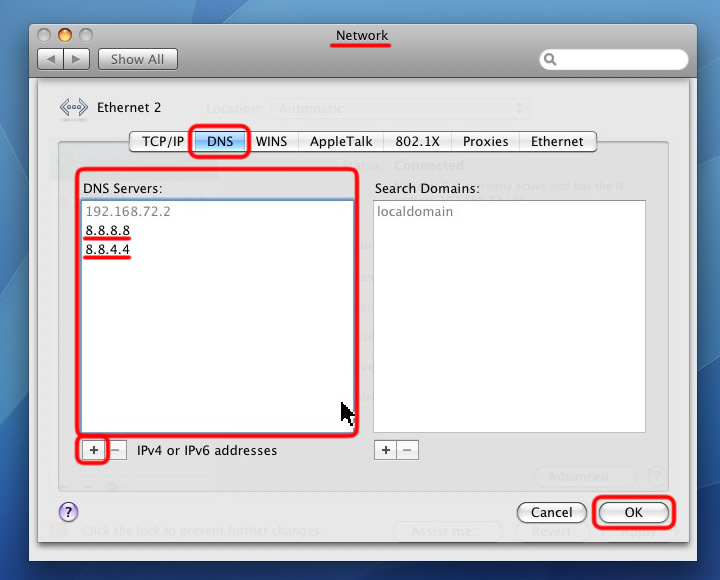Add a hosts file entry without jailbreaking. Ask Question. Is there a way to add a hosts entry (/etc/hosts) for that server in iOS, or add the appropriate domain name to the resolver search list without jailbreaking? Or else you can set up any mac as a DNS server. Dec 05, 2015 How to Change DNS Server Settings in Mac OS X. Thank you Eduardo. I’ll try it that way. I guess I thought you could just add servers to the list and retain the.

I have an iPad that needs to be able to connect to a server via its short hostname, e.g. http://app instead of http://app.example.com. The network it connects to assigns it a domain name other than example.com so it doesn't work automatically.
Is there a way to add a hosts entry (/etc/hosts) for that server in iOS, or add the appropriate domain name to the resolver search list without jailbreaking?
5 Answers
Use Weblock - AdBlock for iOS app to create a redirect rule from http://app to the IP and port you like.

(Only works when on a WIFI network)
No, but as a work-around, you could have your iPad proxy to a Mac on your home LAN and then do the DNS trickery there.
(I'm assuming that you need this ability during debugging/testing, not 'everywhere.')
TJ LuomaTJ LuomaIn general, editing the Hosts file is a bad solution. I only use it for temporary testing, and always remove any hosts file entry a few minutes after adding it.
You should be using a DNS server of some kind to setup your custom domain, perhaps this is possible with your wifi router, or else you can set up any mac as a DNS server.
As a nice side benefit, having your DNS server on the LAN will make your internet noticeably faster. Most people are using their router as a DNS server and they really are not fast enough to implement DNS properly. It's a good idea to use a fast remote DNS server (which one is best will depend on what city you live in), but having one on your LAN is even better.
You can google for instructions how to setup bind on any mac, it's free. Or you can purchase Lion Server from Apple in the App Store, and download Server Admin Tools to configure bind with a nice GUI (with Lion, unlike Snow Leopard, you have to download Server Admin Tools separately form buying a license for Mac OS X Server. Basically they've separated the advanced server tools out into a separate download from the basic ones).
Actually, there is a way.Create your own app including a network extension that filters DNS queries using NEPacketTunnelProvider and parsing IP packets manually.I already have it, working perfectly, and will upload it in a few days. I will add the possibility to upload host files too.Although 7 years ago this was not technically possible.
You must log in to answer this question.
Not the answer you're looking for? Browse other questions tagged ipadioshosts .
Add Manual Dns Entry Macbook Pro
If you aren’t happy using the default DNS servers your ISP or local coffee shop provides with your Mac, you can change them. It’s pretty easy to do. Follow along to learn how.
What is DNS
Add Manual Dns Entry Machine
DNS, or domain name service, is what your Web browser uses to translate the URL you enter (like macobserver.com) into the numeric addresses, or IP address, computers use. Typing apple.com in your browser, for example, is a lot easier than remembering 17.142.160.59.
Your ISP has its own DNS servers and automatically provides those when you connect to the Internet. The same thing happens when you connect to public networks in places like coffee shops, libraries, and hotels.
That isn’t necessarily a problem, but if you’re concerned your ISP is tracking and selling your website requests, changing your DNS entries is the way to go. It also ensures the public networks you connect to don’t get to collect the URLs you enter.
Changing Your Mac’s DNS Server Address
You aren’t limited to the DNS servers your ISP or local coffee shop assigns. Adding the servers you want takes only a few steps.
Here’s how to add DNS servers to your Mac’s network settings:
Add Manual Dns Entry Machines
- Choose
- Select the network connection you want to modify. I started with my WiFi connection, then changed my Ethernet adapter connection, too.
- If you use your passcode to lock down settings don’t forget to click the Padlock and authenticate
- Click
- Choose the
- Click the
- Enter the DNS server address you want to use. Your Mac supports both IPv4 and IPv6 addresses.
- Press
- When you’re done adding DNS addresses, click
- Click
Your Mac starts at the top of the list to choose the DNS server it’ll use. If for some reason the first isn’t available, your Mac moves on to the next. If none of those work, your Mac will look to your router for an entry.
You can change the order of the entries in your DNS list with a quick click and drag. To remove an address, just select it and click the Minus button at the bottom of the DNS Servers list.
iPhone, iPad, and iPod touch owners can set DNS servers, too. Andrew Orr does a great job of explaining how.
DNS Server Alternatives
Now that you know how to change the DNS server entries on your Mac, here are some options to choose from, like OpenDNS and newcomer Cloudflare:
- 8.8.8.8
- 8.8.4.4
OpenDNS
- 208.67.220.220
- 208.67.222.222
Quad9
- 9.9.9.9
Cloudflare
- 1.1.1.1
- 1.0.0.1